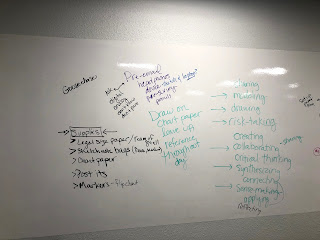Last week during a district staff development, we watched Angela Duckworth's TED talk on Grit, and our school leadership teams discussed ways to help reinforce the idea of a growth mindset and the importance of perseverance in problem solving. This weekend at an ASCD conference, my first session was on "Fostering Grit," and our presenter referenced Carol Dweck's work on mindset and Duckworth's research on grit. Finally, this week's #eduread article was also about developing perseverance in problem solving, specifically with math problems.
Message received! I need to be intentional about teaching students (and teachers) the importance of grit, how to develop a growth mindset, and that failures help you learn and succeed. After finishing our article Faster Isn't Smarter, I knew this objective needs to be a priority.
Luckily, I'm not starting from ground zero, but I know I can do much, much more. For the past two years, we have talked mindset in my classes, and we call my challenge problems on assessments #growthmindset questions. When I first started my work as an Instructional Specialists, my work partner and I heard the phrase "Glorious Struggle," and we used that when we were having a hard time with our job (which was quite often during the first year!) and I taught the same phrase to my students. Yesterday, I created my first TEDEd lesson on Duckworth's talk, and I will ask my students to watch and reflect on her message. In the past, I talked to my students about "Famous Failures," and last summer, I created the Google presentation with quotes on failure, success, and struggle, and shared it with them.
Our presenter at the ASCD conference was Thomas R. Hoerr, and he leads a "Multiple Intelligences" school where teaching grit is one of top objectives for teachers and students. In his session, he offered six steps for teaching grit, and these ideas also align with some of the points in Cathy Seeley's article.
Teaching for Grit
- Establish the environment. Students must realize that they are cared for and supported, even when they're struggling. (How many times have we heard that it all boils down to relationships??) When teaching grit, how can we acknowledge effort and improvements? How can we make it "cool" for students to be seen working hard? Have posters in your room or hallways about effort, success, and hard work.
- Set the expectations. Students must understand the value of grit and accept that learning is not always easy or fun. Seeley says the same thing in her article. Teach that mistakes are good lessons, and there are such things as good failures! (At a different session, we watched "My Favorite No," which I think would help here.) Teach the students about the brain research, too!
- Teach the vocabulary. Hoerr asks his teachers to frequently use words like grit, growth mindset, frustration, and comfort zone when talking with students and parents. (Seeley had the same reflections in the "For Families" section of the article.)
- Create the frustration. Another way that my edu-worlds collide: Hoerr suggests to differentiate by process, and ask students to solve problems using an intelligence that was not their dominant intelligence. (Referencing last week's #eduread article, instead of using the Mastery or Understanding styles, require students to solve a problem as a Self-Expressive or Interpersonal learner.) Another idea, tell students that "Today is a GRIT day," and the tasks, instructions, or the final product will be intentionally challenging. Seeley called it constructive struggling, which I loved! In math, create problems that are complex and require more than just a rote procedure.
- Monitor the experience. Watch your students and their emotions. Solicit feedback during the gritty experience, either using non-verbal signals or a Likert scale on the work and frustration level. We don't want students to feel pointless frustration.
- Reflect and learn. Ask the students to share why they didn't give up on a particular task. What did they do that will help them in the future when they're frustrated again?
Hoerr also provided a few steps for how to teach students to keep persevering, and this is something that I will start at the beginning of the year:
- "Anticipate the level of difficulty." Ask student to self-assess and guess how difficult they think today's work will be.
- Before beginning the work, ask students to reflect on a time where they have succeeded on something (in academics or outside of school).
- During the task, require students to give 5 full minutes of full-force effort.
- Remind students of the power of a "good failure."
Again, so much to think about...looking forward to the upcoming #eduread to help reflect on these questions!
Jumping to the top of my to read list: Paul Tough's book How Children Succeed: Grit, Curiosity, and the Hidden Power of Character
(Side note--his recent NYT article was another great commercial for teaching grit and perseverance as a "2nd curriculum," and sounds like AVID for college!)


